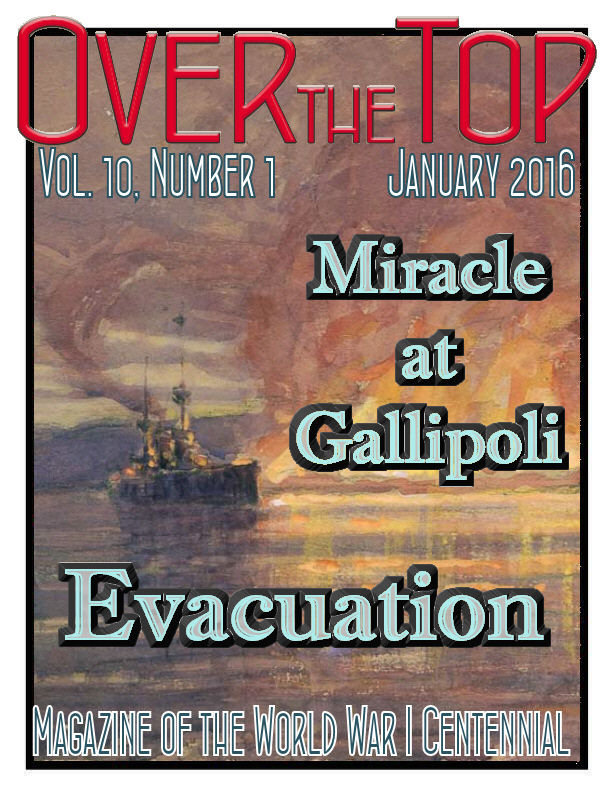
January
2016 |
 |
|
|


1916 Centennial 2016
Here's what you can look for in the coming year from all our publications at Worldwar1.com, including the St. Mihiel Trip-Wire, our Roads to the Great War daily blog, Over the Top magazine, and our constellation of educational websites:
Military operations: the Gallipoli Evacuation, Verdun, the Somme, Jutland, Austria's Asiago Offensive, the British Defeat at Kut, and America's Punitive Expedition into Mexico, under the command of future AEF Commander John J. Pershing; three key commanders of 1916: Philippe Pétain, Aleksei Brusilov, and Franz Conrad von Hötzendorf; arresting Great War imagery from then and now; reviews and recommendations for your WWI bookshelf; and STUFF we haven't even thought of yet.
Also, since Worldwar1.com is a partner with the United States Centennial Commemoration Commission, Trip-Wire readers will get the inside poop on all aspects of America's remembrance of its wartime experience.
MH

|
2016
Southwest Branch of the WW1 Historical Assoc.
When: 23 January 2016, 10 am
Where: Schulenberg, TX, Holiday Inn Express
Program: German SW Africa, Medicine, Cavalry & War Poets; click (kihnt@swbell.net) to RSVP.
Over the Front, Mid-Atlantic Chapter Meeting
When:23 January 2016, All Day
Where: National Air and Space Museum’s Steven F. Udvar-Hazy Center
Sponsors: The League of WWI Aviation Historians; click (email BobrowC@si.edu) for full program and details.
|
Local and Ongoing Events
The interest in the Great War generated by the Centennial commemorations has led to an explosion of local events and ongoing displays of art and artifacts from the war. The Centennial Commission has taken on the job of providing a list of all these presentations they hear about. Click HERE to view the current list.
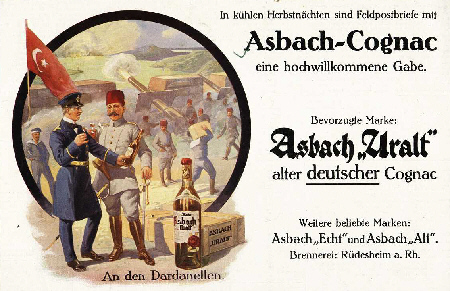
Wartime Advertisement:
Celebrating Victory at the Dardanelles
|
Return of the Ratcatchers
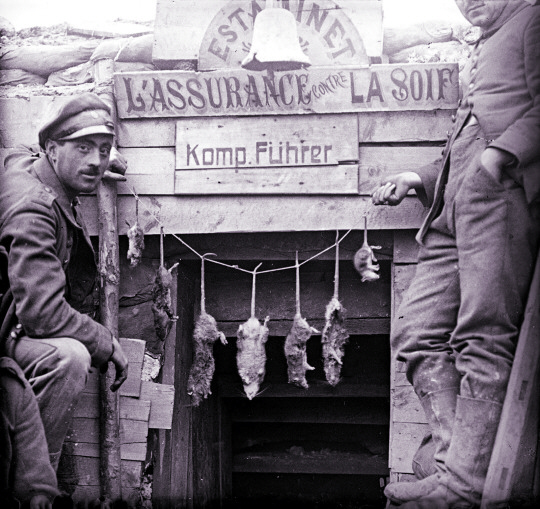
Posing Before Their Neighborhood Bistro, "Insurance Against Thirst," Are Proud Winners of a Company-Level Competition

Salonika Ramps Up
By late 1915 with the Gallipoli Campaign clearly failing things started heating up in the nearby Balkans as Bulgaria joined the Central Powers. The Serbian Army was in jeopardy and the Allies decided to reinforce the theatre. To many the effort seemed to simply create another sideshow, where troops needed on the Western Front could be wasted. Surprisingly, though, it would be the zone where the final collapse of the Central Powers as a fighting alliance would begin in 1918. It's a complicated but interesting tale.
 The Allies Begin Moving to Macedonia: October 1915
The Allies Begin Moving to Macedonia: October 1915
 Map of the Salonika Front
Map of the Salonika Front
 Overview of the Salonika Front
Overview of the Salonika Front
 The Baffling Story of Greece in the First World War
The Baffling Story of Greece in the First World War
 The Story of the Salonica Army
The Story of the Salonica Army
 Forgotten Fronts: Muckydonia 1916 (Photos)
Forgotten Fronts: Muckydonia 1916 (Photos)
 Photos of French Forces in Macedonia (scroll for green slideshow icon)
Photos of French Forces in Macedonia (scroll for green slideshow icon)

What's He Famous For?
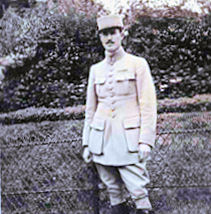
Somewhere in France
This is Corporal Kiffin Rockwell from Newport, Tennessee, of the Lafayette Escadrille. He was the first American to shoot down an enemy aircraft in the war. He did not survive the fighting. Still flying despite serious earlier wounds, he was killed in action 23 September 1916 near Luxeuil, France, where he is buried. He will be remembered as part of the 100th anniversary commemoration of the escadrille. (Details below.)

New Years Day 1916
It is hard to say anything about the war. There seems to be a calm before the storm. No one knows what is coming next. What it will lead to and how long it will last. The state of exhaustion here is already very great, and even in Germany they are no longer unhesitatingly optimistic.
Sigmund Freud in Vienna, Letter
|

|

U.S. Centennial Organizations & Resources
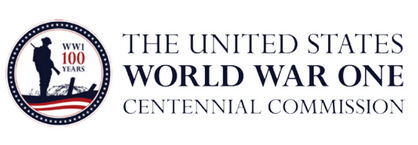
worldwar-1centennial.org/
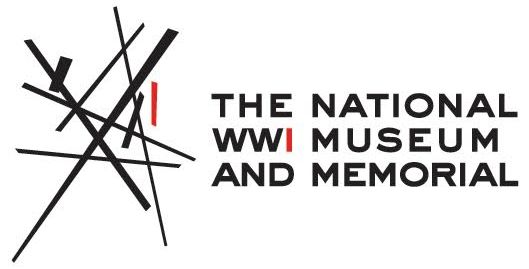
theworldwar.org/
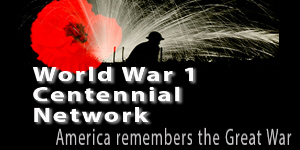
www.ww1-centennial.org/
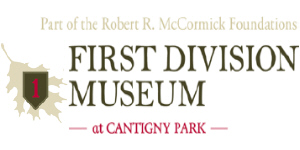
www.firstdivisionmuseum.org/

www.abmc.gov/
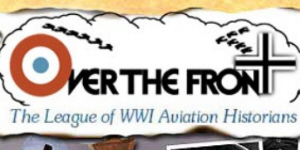
www.overthefront.com/
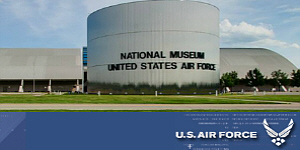
www.nationalmuseum.af.mil/
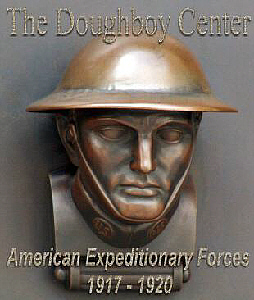
www.worldwar1.com/dbc/
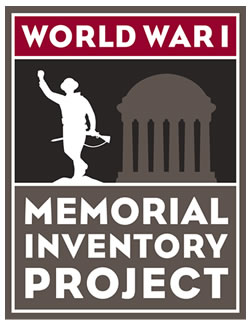
facebook.com/wwiinventory
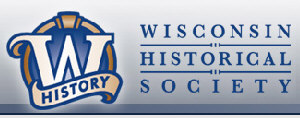
wisconsinhistory.org/
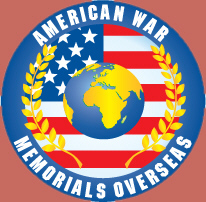
www.uswarmemorials.org/
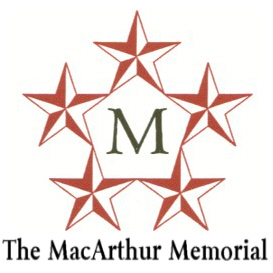
www.macarthurmemorial.org/

www.saving-hallowed-ground.org/
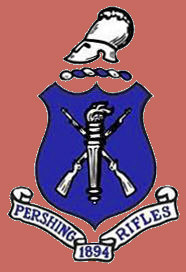
www.theprgroup.org/
Support Worldwar1.com's Centennial Effort
Shop at Amazon.com
|
The Centennial Ticker
America's Big Centennial Events of 2016
The Selection of the Design for the
National World War I Memorial
On 20 January an event that your editor has hoped for these past 30 years will take place. The design concept and team for America's long overdue World War One Memorial will be announced. Here are the five competing final designs.

America's Big Centennial Events of 2016
The Rededication of the
Lafayette Escadrille Memorial
This monument outside Paris honors the American volunteer pilots who flew with the French military prior to and after the United States' entry into WWI. Many volunteers elected to transfer to the U.S. Army Air Service after America entered the war and served as the core of combat experienced pilots for what became today’s U.S. Air Force. The memorial is also the burial site for 28 aviators, all Americans who served with France's air service, save one unknown, Lt. Col. George Thenault, the French commander of the squadron (NS.124), and his superior, General Felix Brocard.
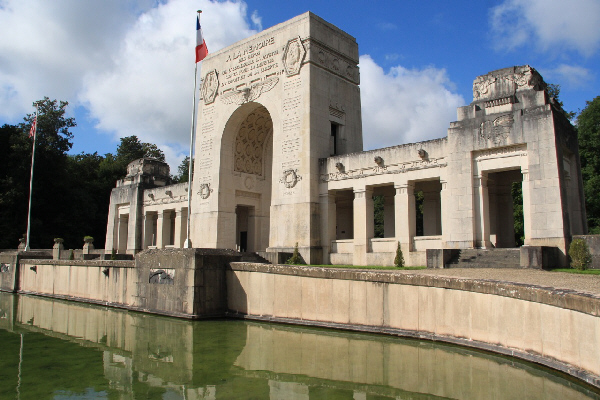
The Memorial in August 2014
Note Wear and Tear and Discolorations
Roughly 200 American volunteer pilots flew for France before the US entered World War I. Writ large, these Americans were informally known as the “Lafayette Flying Corps.” A small group of these pilots were specifically brought together to create an all-American squadron in April 1916, which ultimately became known as the “Escadrille Lafayette”, or Lafayette Squadron (NS.124). The intent of an all-American squadron was to highlight the war effort to the American public and generate support for the Allies. The squadron participated in all major campaigns of the war and downed numerous enemy aircraft.
Approximately one year after the Escadrille Lafayette was formed the United States entered the war. As the fledgling US Army Air Service began to stand up operations, a decision was made to allow combat-seasoned Lafayette Corps volunteer pilots to transfer into its ranks. Men such as Raoul Lufbery, Walter Miller, Hugh Terres, and David Putnam shared their combat experience with inexperienced US Army pilots, influencing the employment of military airpower in the Great War and shaping its future as an individual combat force in the years to come.
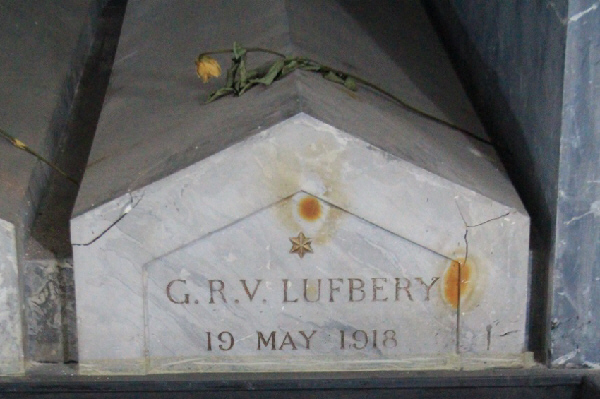
Water Damage on the Sarcophagus of Raoul Lufbery
One of America's Greatest Aviators
Of the 200 American Lafayette Corps volunteers, 68 would die before the war’s end, many while wearing the uniform of the US Army Air Service. The memorial pays tribute to sacrifices of those men, the historic efforts of all Lafayette Corps volunteer pilots, and commemorates the long standing friendship between France and the United States, where each has come to the other's assistance in defending liberty and freedom.
Economic crises over the years led to a reduction of financial resources available to care for the structure, which led to the memorial falling into a significant level of disrepair as late as 2001. But a heroic effort has been made to fund improvements and complete restoration of the memorial to correspond with the 100th anniversary of the escadrille's first combat.

The Memorial Under Full Restoration in Late 2015
A grand commemoration is being planned. Kiffin Rockwell (mentioned above) will be honored on 18 April at Luxeuil, France. The main public event will be on the morning of 20 April 2016 at the memorial site, the Parc de Villeneuve-l'Étang at Marnes-la-Coquette just outside Paris. More information will be shared as it becomes available.
|
|

January 1916
President Wilson Catches Preparedness Fever
President Woodrow Wilson originally believed the United States could and should remain in a posture of unarmed neutrality during the fighting in Europe. However, as Harold Macmillan later specified what a prime minister most feared ('Events, dear boy, events.") events would force a shift in Wilson's thinking. After the Lusitania was sunk by German U-boats on 7 May 1915 several organizations were formed around the idea of getting America prepared in case the nation was forced into the war. This "Preparedness Movement," with spokesmen like former president Theodore Roosevelt, held parades and organized opposition to Wilson's policies. Wilson's attitude, possibly more out of political necessity than conviction, publicly changed. He decided to actively advocate Preparedness and began outlining his views during a whistle-stop tour launched in New York City to make the case for the new policy on 27 January 1916. This, of course, marked a decisive shift in national policy and was — in hindsight — a major landmark on America's journey to the battlefields of Europe.
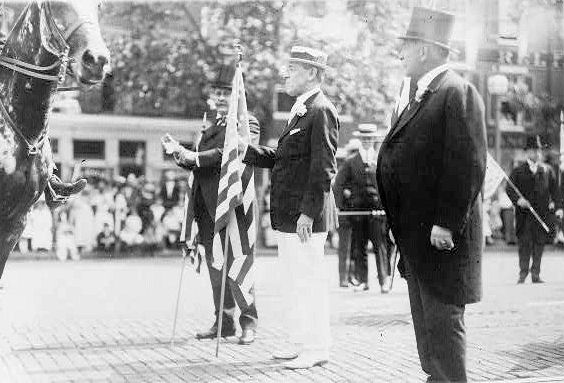
President Wilson at the Start of a Preparedness Parade
Quotes from his speeches made on that tour are quite interesting. They reveal a different Woodrow Wilson than is usually portrayed by historians. Some of his comments also seem directed to a different sub-species of Homo Sapiens Americanus than now occupies the country.
The World is on fire. . . The world is fire. . .there may be material which cannot prevent from bursting into flame. . . America can't afford to be weak. . . Some men who are not real men love other things about themselves, but the real man believes that his honor is dearer than his life; and a nation is merely all of us put together, and the nation's honor is dearer than the nation's comfort and the nation's peace and the nation's life itself. . . America cannot be an ostrich with its head in the sand. . . There is a price which is too great to pay for peace, and that price can be put in one word. One cannot pay the price of self-respect.
|
|

Announcing Our 2016 Centennial Battlefield Tour Schedule

10% Discounts Available for Our 2016 Tours
2 - 10 May 2016: Verdun In-Depth
Rooms are still available. Book soon, though.
14 - 21 August 2016: The Somme In-Depth
10% off ($320) if you pay by 2 February 2016, 5% if you send your deposit by that date
The full brochure covering both trips and registration details can now be downloaded at:
(http://www.worldwar1.com/pdf/ValorTours_2016Flyer.pdf)
|
|
|

|

This Month's Recommended Books
The 1916 Battles of Legend
Four of the most famous battles of the Great War took place in 1916: Verdun, the Somme, the Brusilov Offensive, and big-ship Battle of Jutland. Learn about them, or brush up on them with some of these excellent works.
|
Reload page if any book covers fail to appear.
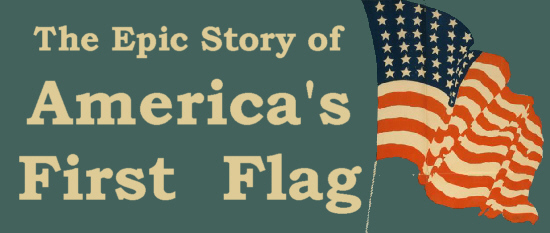
The First Flag (III):
The Service and Death of Arthur "Clifford" Kimber
Bearer of the First Flag
By Patrick Gregory
|
Although he left from Palo Alto and the San Francisco Bay Area as a Stanford volunteer, Arthur "Clifford" Kimber was not a native of California. The family had only moved west from New York eight years before when his father, a clergyman, had died suddenly in the summer of 1909. It had been a terrible loss for a still young family: for his widow Clara, more than 20 years his junior, and for his three sons John, Clifford, and George. At 13, Clifford was the middle child.
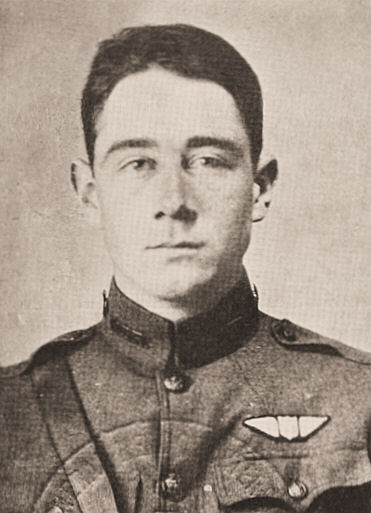
Lt. Arthur Kimber, U.S. Air Service
Formerly American Field Service
|
The Rev. Arthur Kimber had been a dynamic and inspiring figure, not just to a family who looked to him for his love and support but to a large body of parishioners in downtown New York. Thousands of men and women, many of them recent immigrants to the United States, flocked to his mission church in Manhattan's Lower East Side. He was the vicar of St. Augustine's, an Episcopal church in the city's Bowery, an area which acted as a magnet for the city's dispossessed or newly hopeful. St. Augustine's offered spiritual, and a good deal of practical, support on the way to a new life. The mission was an offshoot of Trinity Church on Broadway and Wall Street, the main Episcopal church of New York and by comparison to St. Augustine's possibly the wealthiest parish in the United States. Kimber senior had been appointed in 1872 to head up this new offshoot, something he devoted himself to over the following 35 years. But it was another aspect of Kimber's ministry, his social activism, which brought him into contact with New York's public authorities along the way, working with them to try to find practical as well as religious solutions to the city's problems. During the mid-1890s he worked through the city's Police Board, cooperating with Theodore Roosevelt, then Police Commissioner for the city in a campaign to curtail the city's drinking hours. That was before the young Arthur Clifford had even been born, yet pride in the memory of his father's work and his common cause with Roosevelt fired the young Kimber in his teenage years.
By the time Kimber was growing up in California Roosevelt had already reached and departed the political summit, yet the former president remained young Kimber's political hero. It was no accident, therefore, that he sought out Roosevelt before he set out for Europe in 1917, anxious to receive some words of wisdom from the great man. Later still, and in France the following year, Kimber was just as pleased to have trained as a pilot alongside Roosevelt's youngest son, Quentin — 'QR' — whom he described in his letters home as "a pretty good sport [who] has lots of life [and] is absolutely democratic and very well liked".
But whatever political allegiances passed down by his father, or indeed any more personal or moral qualities he instilled in his middle son, there was another more practical inheritance which young Clifford was gifted by the Rev. Kimber — an interest in gadgetry and machines. That gadgetry included the latest form of transport then being pioneered, aviation. In spite of his clerical training and background, Arthur Kimber was a man who also thought and taught with his hands — practical life skills to parishioners, as well as busying himself in his workshop at home with all manner of mechanical projects and inventions. Clifford was an avid student and helper in all his workshop activity. In time, in 1907/08, he and his elder brother spent a year at a school in Canterbury in England, and it was after their spell there that the Rev. Kimber took his two older boys for a holiday in continental Europe. There, on 8 August 1908 in France, the three were in the crowd at a horse-racing track at Hunaudières near Le Mans to witness Wilbur Wright making the first official public demonstration of his Wright Model A. aircraft, the flying machine he and his brother Orville had designed. It was a flyaway, runaway success. It wowed the crowds and Clifford Kimber was hooked.
After his father's death the following year he and his brothers — now relocated to California — found solace in aping the exploits of Wright, taking to the hills near the various homesteads where they lived, to build and fly gliders. They formed a little club and poured what money they earned locally into the materials needed to build the gliders, with the rather more daring Clifford acting as chief architect and pilot, even if all was not plain sailing. There were mishaps on the way, failed attempts which reduced the carefully assembled wooden constructs to firewood. His mother, Clara, in a memoir many years later, recalled her son taking off in one especially large glider and flying it from Cragmont in the Berkeley Hills, crashing further down the slopes. He emerged largely unscathed, if $10 the worse off, but at least one San Francisco newspaper jumped the gun to publish untimely — and erroneous — accounts of his death.
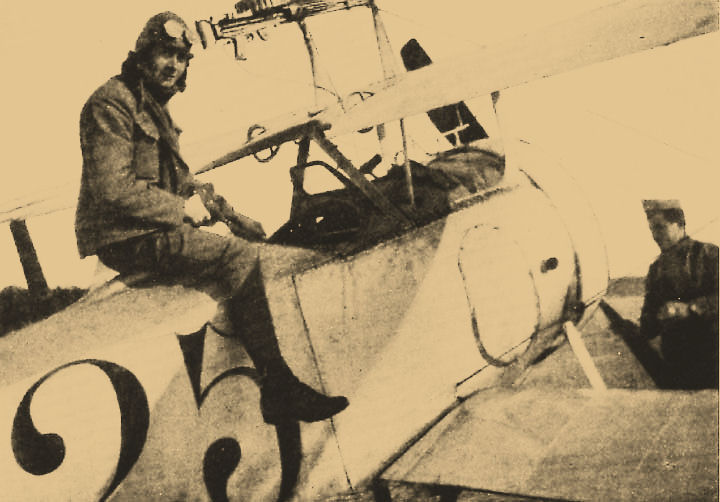
Kimber During Training
It was that flying bug which inspired him years later to apply for a posting to the nascent U.S. Air Service in France. Within a matter of weeks of joining the ambulance corps he had written to Edmund Gros, a San Franciscan of French heritage who was the medical director of the American Field Service. Gros, a physician, managed to combine his medical duties for the American Ambulance with a different role — that of the de facto organizer of early American aviation efforts in France. It was he who had helped create the Lafayette Escadrille, the original unit of American pilots who flew with the French air service from 1916, and the "Lafayette Flying Corps", the later American foreign legionnaires who would fly with a variety of other French squadrons. Ambulance volunteer Kimber wanted to be part of Gros's plans and to play an active combat role in the war and thus wrote to him in Paris. After some negotiation and medicals Kimber was accepted in September 1917 for the American air arm proper, now beginning to be pieced together.
Clifford Kimber spent the next year in aviation service, the first six months in training over the winter of 1917/18. It was an exacting schedule of first basic, and then advanced training schools, finally being tutored at a third camp in aerial gunnery techniques. Yet delays afterward — delays in transporting a vast force of men and materiel to Europe as well as the wrangling still going on as to the American Expeditionary Force's exact role and theatre of operations — saw him frustratedly having to cool his heels for a time. He then acted as a "ferryman", delivering warplanes around France from distribution depots and airfields.
But finally it was time for active service as Kimber went into combat with both the French Air Service — Escadrille Spa. 85 — and the U.S. Air Service's 22nd Aero Squadron, seeing action across the front in northeastern France in the summer and early autumn of 1918. Kimber fought with the 22ndduring the Americans' St. Mihiel campaign, narrowly escaping with his life in an attack by enemy fighters. Acting as his patrol's rear guard, he was jumped by a group of Fokker aircraft and his plane riddled with gunfire. 'Unreasonably shot to pieces' in the restrained words of the squadron's official historian, Arthur Raymond Brooks.

Lt. Kimber's Cross at
the Meuse-Argonne Cemetery
|
Yet less than two weeks later Kimber's luck ran out. It was late in the morning of 26 September 1918, the opening morning of the Meuse-Argonne campaign, when the young lieutenant led a patrol to strafe roads to the north of the German Kriemhilde Stellung battle-lines. Descending from the clouds on an enemy gun battery in the village of Bantheville, his Spad XIII fighter was hit by a shell from the ground. The plane exploded and Kimber fell to his death. The moment was witnessed by the fellow members of his patrol who saw the remnants of the aircraft plunge to the ground, yet his body was not recovered at the end of the war.
It took another three years for that to happen, before his body was finally identified in an unmarked grave in the village. A year after that in the summer of 1922, 1st Lieutenant Arthur Clifford Kimber was finally reinterred in an official plot, only a matter of miles from where he had fallen. His grave can today be found towards the back of the American military cemetery at Romagne-sous-Montfaucon, in one of the final rows of the last plot. An early volunteer for the war in France, he came to be one of the last buried there.
© Patrick Gregory 2015
Adapted from the forthcoming An American on the Western Front: The Letters of Arthur Clifford Kimber, Patrick Gregory & Elizabeth Nurser (The History Press, UK, June 2016)
|
|
|
Thanks to each and every one of you who has contributed material for this issue. Until our next issue, your editor, Mike Hanlon. |
|
 (Or send it to a friend)
(Or send it to a friend)
|
Design by Shannon Niel
Content © Michael E. Hanlon
|
|
|











